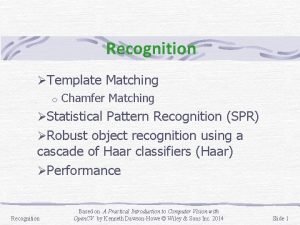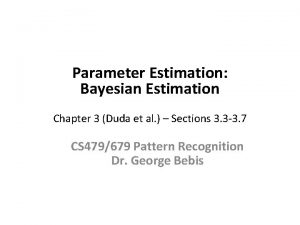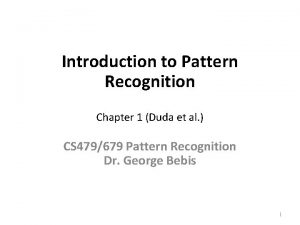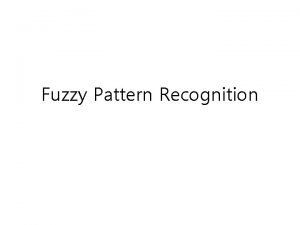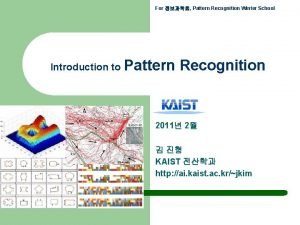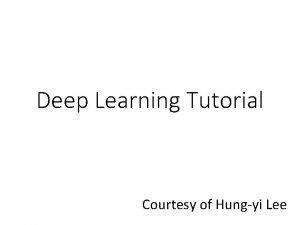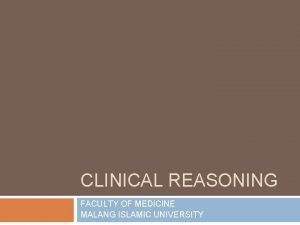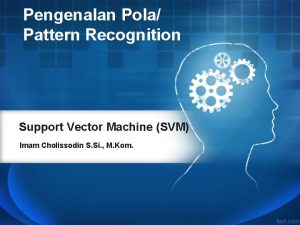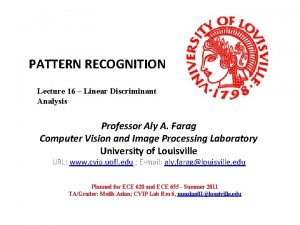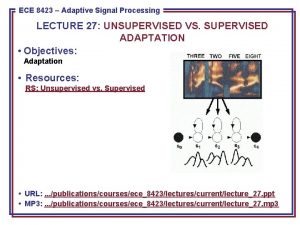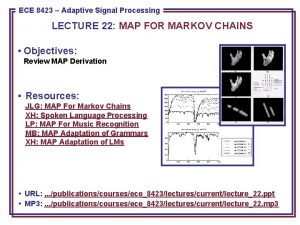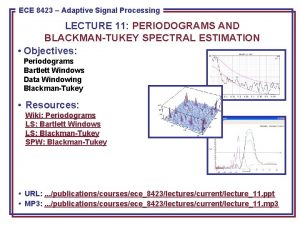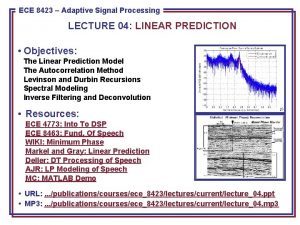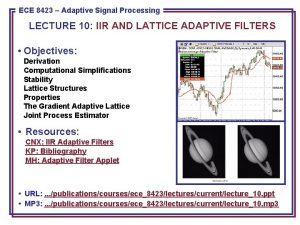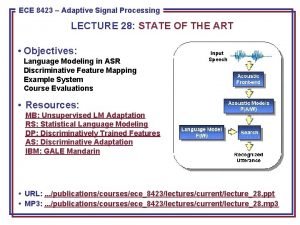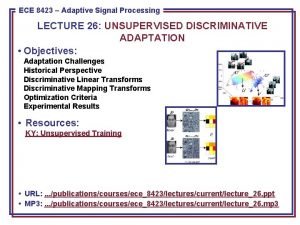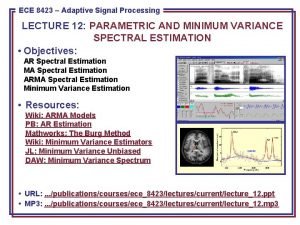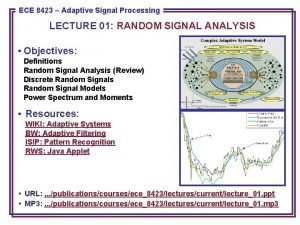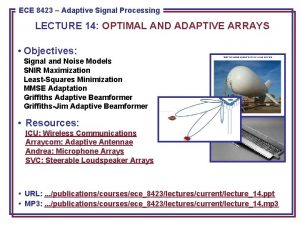ECE 8423 8443Adaptive Pattern Recognition ECE Signal Processing












- Slides: 12

ECE 8423 8443––Adaptive Pattern Recognition ECE Signal Processing LECTURE 06: APPLICATIONS OF ADAPTIVE FILTERS • Objectives: Adaptive Noise Cancellation ANC W/O External Reference Adaptive Line Enhancement Least Squares Solution Convergence • Resources: RK: ANC Tutorial MATLAB: ANC Toolbox CNX: Interference Cancellation WIKI: Weiner Filtering RICE: Weiner Filtering • URL: . . . /publications/courses/ece_8423/lectures/current/lecture_06. ppt • MP 3: . . . /publications/courses/ece_8423/lectures/current/lecture_06. mp 3

Adaptive Noise Cancellation • One of the most important applications of adaptive filtering is adaptive noise cancellation (ANC). + – • Originally proposed by B. Widrow in 1975. • ANC is concerned with the enhancement of noise corrupted signals. • Requires no a priori knowledge of the signal or noise. • Variation of optimal filtering which uses a secondary, or reference, signal. • This reference measurement should contain no signal and noise that is correlated with the original noise. • Relation to adaptive filtering paradigm from previous lecture: the desired signal is replaced by the primary signal (signal + noise), and the system input is replaced by the reference. • The output is the error signal. ECE 8423: Lecture 06, Slide 1 – +

Reference Signal is Critical • The signal is measured in a noisy ambient environment (e. g. , a hands-free microphone in a car). • The noise is measured from a different location, typically close to the noise source (e. g. , under the driver’s seat in a car). • The noise estimate need not be the exact noise signal added to the speech signal, but should be related through a linear filtering process. In practice, this is often not the case. • The error signal can be written as: • Squaring and taking the expectation: ECE 8423: Lecture 06, Slide 2 + –

Filter Analysis • It is assumed that s(n) is uncorrelated with v 0(n) and v 1(n). • Hence, for a fixed filter, s(n) is also uncorrelated with . • The expectation of the error reduces to: • Recall we can also solve for the filter using the z-transform: + • For our ANC system: – • The noises v 0(n) and v 1(n) are correlated in some way. We assume they can be modeled using a LINEAR filter (and this is a big assumption!): ECE 8423: Lecture 06, Slide 3

Estimating The Filter • We note that: • Further: • Therefore, the adaptive filter models the unknown transmission path, h(n): • To verify this: • In practice, there can be signal leakage between d(n) and x(n). Assuming we can model this as a linear filtering: • Effectively a signal to noise (SNR) ratio. ECE 8423: Lecture 06, Slide 4

Additional Comments on ANC • We can characterize the performance of the system in terms of the signal to noise ratios of the system output and the system reference: • That is, the SNR of the output (the error) is inversely proportional to the SNR of the reference (x(n) contaminated by noise). • Hence, the more leakage, the worse the ANC result. • This analysis assumes an idealized approximation of the adaptive filter as a fixed, infinite, two-sided Wiener filter. It neglects issues of stability, convergence, and steady-state error. • Nevertheless, one-sided, or causal filters, do extremely well in this process. Many simplifications and optimizations of this approach have been implemented over the years to produce very effective technology (e. g. , noisecancelling headphones). ECE 8423: Lecture 06, Slide 5

Adaptive Line Enhancement • In some applications, the signal of interest is an extremely narrowband signal that can be modeled as a sum of sinewaves. + – • To cancel noise in such cases, we invoke a special form of an adaptive filter known as adaptive line enhancement (ALE). • We can write the output, y(n): • The goal of the system is to maximize the SNR: • The input signals may be written as: • Assume a solution of the form: • Recall the normal equation: ECE 8423: Lecture 06, Slide 6

Solution of the Normal Equation • For our application: • Hence, our normal equation becomes: • Combining the normal equation with our assumed solution: • Noting that ECE 8423: Lecture 06, Slide 7 and

Solution of the Normal Equation (Cont. ) • The solution to this equation: is provided by: • We can write this in terms of the SNR: • We have essentially verified that the matched filter solution is optimal in a least squares sense (see the textbook). • As we would expect from a least squares solution, the results are independent of the phase of the signal. • All that is needed for the least squares solution is the auto and crosscorrelation coefficients, which can be estimated from the data. ECE 8423: Lecture 06, Slide 8

SNR Gain • The output of the filter can be computed via convolution: • The output consists of two terms: • The output noise power is: • The output SNR is: ECE 8423: Lecture 06, Slide 9

Convergence of the ALE Filter • The convergence properties of this filter are very similar to what we derived in the general LMS case: • For the ALE system: • However, estimating the noise power may be problematic, especially when the noise is nonstationary, so conservative values of the adaptation constant are often chosen in practice. ECE 8423: Lecture 06, Slide 10

Summary • We introduced two historically significant adaptive filters: adaptive noise cancellation (ANC) and adaptive line enhancement (ALE). • We derived the estimation equations and the SNR properties of these filters. • We discussed what happens when less than ideal conditions are encountered. ECE 8423: Lecture 06, Slide 11
 Pattern and pattern classes in image processing
Pattern and pattern classes in image processing Four part processing model for word recognition
Four part processing model for word recognition Four part processing model for word recognition
Four part processing model for word recognition Template matching pattern recognition
Template matching pattern recognition Bayesian parameter estimation in pattern recognition
Bayesian parameter estimation in pattern recognition Pattern recognition duda
Pattern recognition duda Fuzzy classification in pattern recognition
Fuzzy classification in pattern recognition Design cycle of pattern recognition
Design cycle of pattern recognition Pattern recognition
Pattern recognition Pattern recognition lab
Pattern recognition lab Pattern recognition clinical reasoning
Pattern recognition clinical reasoning Contoh pattern recognition
Contoh pattern recognition Discriminant function in pattern recognition
Discriminant function in pattern recognition



